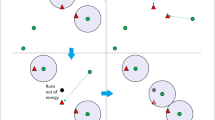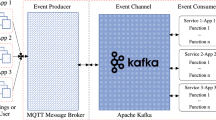Abstract
Sensing devices are expected to interconnect over large geographical areas and federations of wireless sensor networks are expected in a near future. In such environments a critical issue is how to discover the resources available at devices in a scalable manner. For this purpose, a Constrained Application Protocol (CoAP) Usage for REsource LOcation And Discovery (RELOAD), a generic self-organizing Peer-to-Peer (P2P) overlay network service, has been defined to be used as a lookup service, to store available device resources and as a cache for sensor data. Each P2P resource, at the RELOAD/CoAP overlay, includes references to device resources, hosted at one or more constrained nodes, but no provision is made for the insertion of bindings/references to P2P resources already available at the P2P overlay network. Such feature would increase the efficiency and consistency of storage, avoiding duplicate references, a very relevant issue for future IoT applications relying on the federation of wireless sensor networks. In this article an extension to the service provided by CoAP Usage is proposed so that resource bindings can be managed. Two binding models, and a heuristic algorithm for their implementation, are proposed. Results show that such models lead to a better resource organization, reducing the number of sensor resource entries and/or fetches to the P2P overlay.






Similar content being viewed by others
Notes
Each RELOAD node stores part of the resources, according to their keys, resulting into a distributed and scalable storage system.
References
Mäenpää J, Bolonio JJ, Loreto S (2012) Using RELOAD and coAP for wide area sensor and actuator networking. EURASIP J Wirel Commun Netw 2012:121
Shelby Z, et al. (2014) The constrained application protocol (coAP). RFC 7252
Jennings C, et al. (2014) RESource location and discovery (RELOAD) base protocol. RFC 6940
Jimenez J, et al. (2015) A constrained application protocol (coAP) usage for resource location and discovery (RELOAD). RFC 7650
Nottingham M (2010) Web linking. RFC 5988
Nottingham M, Hammer-Lahav E (2010) Defining well-known uniform resource identifiers (URIs). RFC 5785
Shelby Z (2012) Constrained RESTful environments (coRE) link format. RFC 6690
Correia N, Sacramento D, Schütz G (2016) Dynamic aggregation and scheduling in coAP/observe based wireless sensor networks. IEEE Internet Things J 6:3
Ludovici A, Gimeno E, Garcia X, Calveras Auge A (2012) Adding QoS support for timeliness to the observe extension of coAP. In: IEEE conference on wireless and mobile computing networking and communications (WiMob)
Hartke K (2015) Observing resources in the constrained application protocol (coAP). RFC 7641
Shelby Z (2017) CoRE resource directory. draft-ietf-core-resource-directory-10
Jennings C, et al. (2016) A SIP usage for resource location and discovery (RELOAD). RFC 7904
Maenpaa J, Camarillo G (2014) Service discovery usage for resource location and discovery (RELOAD). RFC 7374
Rosenberg J (2010) Interactive connectivity establishment (ICE): a protocol for network address translator (NAT) traversal for Offer/Answer protocols. RFC 5245
Mahy R, Matthews P, Rosenberg J (2010) Traversal using relays around NAT (TURN): Relay extensions to session traversal utilities for NAT (STUN). RFC 5766
Rhea S, Godfrey B, Karp B, Kubiatowicz J, Ratnasamy S, Shenker S, Stoica I, Yu H (2005) OpenDHT: A public DHT service and its uses. ACM SIGCOMM
Cohen R, Katzir L (2008) The generalized maximum coverage problem. Inf Process Lett 1:108
Acknowledgements
This work was supported by FCT (Foundation for Science and Technology) from Portugal within CEOT (Center for Electronic, Optoelectronic and Telecommunications) and UID/MULTI/00631/2013 project.
Author information
Authors and Affiliations
Corresponding author
Additional information
Publisher’s note
Springer Nature remains neutral with regard to jurisdictional claims in published maps and institutional affiliations.
Rights and permissions
About this article
Cite this article
Rodrigues, L., Guerreiro, J. & Correia, N. RELOAD/CoAP architecture for the federation of wireless sensor networks. Peer-to-Peer Netw. Appl. 13, 27–37 (2020). https://doi.org/10.1007/s12083-018-0712-7
Received:
Accepted:
Published:
Issue Date:
DOI: https://doi.org/10.1007/s12083-018-0712-7




